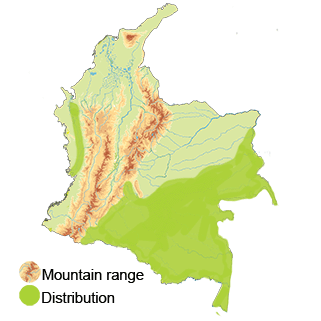Long-tailed Potoo
The Long-tailed Potoo (Nyctibius aethereus) Read in Spanish
Appearance: The Long-tailed Potoo is named for its remarkably long tail, which distinguishes it from other Potoo species. It has intricately mottled plumage in shades of brown, black, and gray with streaks and patterns that aid in its camouflage. The bird's large eyes and wide mouth are adapted for its nocturnal lifestyle, allowing it to hunt insects under the cover of darkness.
Habitat: The Long-tailed Potoo inhabits tropical lowland forests, including rainforests and gallery forests. It prefers dense forest habitats with tall trees where it can roost during the day and hunt for insects at night. These birds rely on their excellent camouflage to blend in with tree bark or branches, making them challenging to spot even in their natural habitat.
Behavior: The Long-tailed Potoo is primarily nocturnal, spending the daylight hours perched motionless on branches to avoid detection. They are expert insect hunters, capturing prey on the wing using their wide mouths. These birds are known for their haunting vocalizations, including mournful wails and whistles, which play a crucial role in communication and territorial defense.
Breeding: The breeding habits of the Long-tailed Potoo involve courtship displays, vocalizations, and the selection of suitable nesting sites in tree branches or forks. Females typically lay one or two eggs in a well-camouflaged nest, where they are responsible for incubating the eggs and caring for the chicks.
Conservation Status: The Long-tailed Potoo is not considered globally threatened.
Distribution
The Long-tailed Potoo (Nyctibius aethereus)
Eastern Andes: The Long-tailed Potoo can be found in the Eastern Andes region, which extends through several departments, including Boyacá, Cundinamarca, Meta, and Tolima.
Within the Eastern Andes, the bird inhabits montane forests and cloud forests, utilizing the dense vegetation and tall trees for roosting and hunting.
Amazon Rainforest: The Long-tailed Potoo is also present in the Amazon region, particularly in the southern part of the country that borders Peru and Brazil. Within the Amazon Rainforest, the bird thrives in the lush tropical forests characterized by high biodiversity and dense canopy cover.
Orinoco River Basin: The Long-tailed Potoo's distribution extends into the Orinoco River Basin in eastern Colombia, covering areas in departments like Arauca, Casanare, and Vichada. Within this region, the bird occupies gallery forests, riverine habitats, and savannas where it can find suitable perches for camouflage and hunting.
Northern Colombia: Reports of Long-tailed Potoos have also been documented in northern Colombia, including regions near the Caribbean coast and Sierra Nevada de Santa Marta. The bird may occur in the foothills of the Sierra Nevada and adjacent lowland forests where suitable conditions for foraging and breeding are present.
Taxonomy
The Long-tailed Potoo (Nyctibius aethereus)
- Kingdom: Animalia
- Phylum: Chordata
- Class: Aves (Birds)
- Order: Caprimulgiformes
- Family: Nyctibiidae
- Genus: Nyctibius
- Species: Nyctibius aethereus
Vocalization
The Long-tailed Potoo (Nyctibius aethereus)
- Calls: The vocalizations of the Long-tailed Potoo are typically described as mournful wails, whistles, and moans that echo through the night in its forest habitat. The calls of the Long-tailed Potoo are haunting and eerie, adding to the mystique of this nocturnal bird.
- Territorial Calls: Male Long-tailed Potoos use vocalizations to establish and defend their territories from other males. Territorial calls may include series of low-pitched hoots, guttural sounds, or repetitive wails that can carry over long distances in the forest.
- Courtship Calls: During the breeding season, Long-tailed Potoos engage in elaborate courtship displays that involve vocalizations and visual cues to attract mates. Courtship calls may be softer and more melodic, with males and females engaging in duets to strengthen pair bonds.
- Alarm Calls: When threatened or disturbed, Long-tailed Potoos may emit alarm calls to alert nearby individuals to potential danger. Alarm calls are often sharp and sudden, signaling to other birds to be on high alert and possibly prompting them to flee or hide.
- Variability: The vocal repertoire of the Long-tailed Potoo can vary across individuals, populations, and regions, with subtle differences in pitch, duration, and rhythm. Researchers continue to study the vocalizations of this species to better understand their communication patterns and social behaviors.
- Importance: Vocalizations are vital for Long-tailed Potoos as they navigate the dark forest at night, locate potential mates, establish territories, and avoid predators. The haunting calls of the Long-tailed Potoo contribute to the ambiance of the nocturnal forest and serve as a key aspect of its behavioral ecology.




